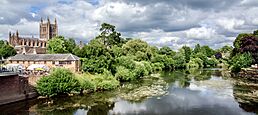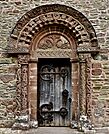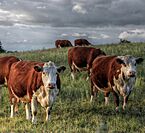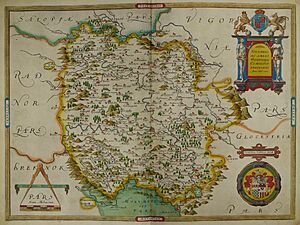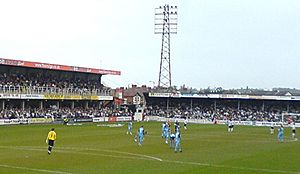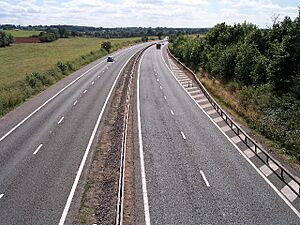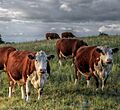Herefordshire facts for kids
Quick facts for kids
Herefordshire
|
|||||||||||||||||||||||||||||||||||||||||||||||
|---|---|---|---|---|---|---|---|---|---|---|---|---|---|---|---|---|---|---|---|---|---|---|---|---|---|---|---|---|---|---|---|---|---|---|---|---|---|---|---|---|---|---|---|---|---|---|---|
|
The River Wye at Hereford, with Hereford Cathedral on the left; the Norman south door of Kilpeck Church; and Hereford cattle
|
|||||||||||||||||||||||||||||||||||||||||||||||
| Motto(s):
"Pulchra terra Dei donum"
("This fair land is the gift of God") |
|||||||||||||||||||||||||||||||||||||||||||||||
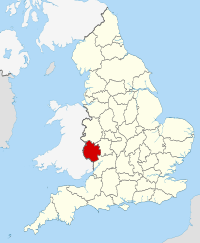 |
|||||||||||||||||||||||||||||||||||||||||||||||
| Sovereign state | United Kingdom | ||||||||||||||||||||||||||||||||||||||||||||||
| Constituent country | England | ||||||||||||||||||||||||||||||||||||||||||||||
| Region | West Midlands | ||||||||||||||||||||||||||||||||||||||||||||||
| Established | 1 April 1998 | ||||||||||||||||||||||||||||||||||||||||||||||
| Established by | Local Government Commission for England | ||||||||||||||||||||||||||||||||||||||||||||||
| Preceded by | Hereford and Worcester | ||||||||||||||||||||||||||||||||||||||||||||||
| Origin | Ancient | ||||||||||||||||||||||||||||||||||||||||||||||
| Time zone | UTC±00:00 (Greenwich Mean Time) | ||||||||||||||||||||||||||||||||||||||||||||||
| • Summer (DST) | UTC+01:00 (British Summer Time) | ||||||||||||||||||||||||||||||||||||||||||||||
| Members of Parliament | List of MPs | ||||||||||||||||||||||||||||||||||||||||||||||
| Police | West Mercia Police | ||||||||||||||||||||||||||||||||||||||||||||||
|
|||||||||||||||||||||||||||||||||||||||||||||||
Herefordshire (/ˈhɛrɪfərdʃɪər, -ʃər/ HERR-if-ƏRD-sheer-,_--shər) is a beautiful county in the West Midlands of England. It is known for its green countryside and farms. Herefordshire shares borders with Shropshire, Worcestershire, Gloucestershire, and parts of Wales.
The biggest town and county capital is Hereford. Herefordshire is one of the most rural counties in England. It covers about 2,180 square kilometers (842 sq mi). Around 187,000 people live here. Besides Hereford, other important towns include Leominster, Ross-on-Wye, and Ledbury.
The county's center is a lowland area. The River Wye and its branch, the Lugg, flow through it. To the east, you'll find the Malvern Hills, a special natural area. The southern part has the Wye Valley, another beautiful national landscape. In the west, the land rises to the Black Mountains. The highest point in Herefordshire is Black Mountain, which is 703.6 meters (2,308 ft) tall.
Herefordshire is part of the historic Welsh Marches, which are lands near the border with Wales. The county is famous for its farms, especially for growing fruit and making cider. It is also home to the well-known Hereford cattle breed.
Contents
- Exploring Herefordshire's Nature
- A Look at Herefordshire's Past
- Who Lives in Herefordshire?
- Herefordshire's Economy and Jobs
- Towns and Villages to Visit
- Learning in Herefordshire
- Farming in Herefordshire
- Symbols of Herefordshire
- Media in Herefordshire
- Sports in Herefordshire
- Cool Places to See
- Getting Around Herefordshire
- Famous People from Herefordshire
- Images for kids
- See also
Exploring Herefordshire's Nature

Herefordshire is full of natural beauty. The River Wye is the fourth-longest river in the UK. It flows through the county, passing through Hereford and Ross-on-Wye. The River Lugg is another important river, joining the Wye near Leominster.
Special Natural Areas
Herefordshire has two "Areas of Outstanding Natural Beauty." These are places with amazing landscapes.
- The Wye Valley is located along the river south of Hereford.
- The Malvern Hills are in the east, bordering Worcestershire.
A Look at Herefordshire's Past
Herefordshire is one of England's 39 historic counties. This means it has been a recognized area for a very long time. The Herefordshire County Council was first set up in 1889 to manage the county.
In 1974, Herefordshire joined with Worcestershire to form a larger area called Hereford and Worcester. But in 1998, the counties separated again. Herefordshire became its own county once more. Today's Herefordshire has almost the same borders as the old county before 1974.
Who Lives in Herefordshire?
The number of people living in Herefordshire grew by 2% between 2011 and 2021. The population increased from about 183,500 to 187,100 people. This growth is slower than the average for England.
Different Backgrounds
In 2021, most people (91.1%) in Herefordshire identified as 'White British'. About 5.1% were 'White Other'. Many people in the 'White Other' group came from Central and Eastern Europe. They started moving to the county in the early 2000s. They often came for farm work, but now work in other jobs too. Poland and Romania are the most common birthplaces for people born outside the UK.
Religions in the County
Christianity is the main religion in Herefordshire. In 2021, 54.9% of people were Christian. This is a decrease from 67.8% in 2011. About 36.6% of people said they had no religion. Other religions like Islam, Buddhism, and Hinduism make up smaller parts of the population.
Traveller Communities
Gypsies and Travellers have been the largest minority group in Herefordshire for a long time. They include:
- Romanichal or Romani people
- Irish Travellers
- New Travellers or New Age Travellers
In 2021, about 600 people (0.2% of the county's population) were part of these groups.
Herefordshire's Economy and Jobs
Herefordshire's economy relies on farming, making things (manufacturing), and services.
Big Businesses in Herefordshire
- Bulmers Cider in Hereford is the world's largest cider factory. It has a huge vat for making Strongbow cider.
- Painter Brothers makes electricity pylons and broadcasting masts.
- Special Metals Wiggin produces special metal alloys.
- Cargill Meats Europe processes chicken from local farms.
- Cadbury (Mondelēz International) makes milk chocolate crumb near Leominster.
- Weston's Cider is another well-known cider maker in Much Marcle.
- Kingspan Insulation is based in Pembridge.
- BT's Madley Communications Centre is a very large satellite communication station.
- Tyrrells Potato Crisps are made in Dilwyn.
Jobs in the County
Most jobs in Herefordshire are in farming, manufacturing, and services. Cargill Meats and H. P. Bulmers are big private employers. The local council and the NHS (National Health Service) are the largest public employers.
Towns and Villages to Visit
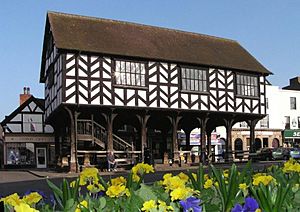
The main places in Herefordshire are:
- Hereford: The only city and the county town.
- Leominster
- Ledbury
- Ross-on-Wye
- Kington
- Bromyard
Learning in Herefordshire
Herefordshire has a good education system. It includes both state schools and private schools. Most secondary schools are for students aged 11–16. There are also colleges for further and higher education. These include Hereford College of Arts and Hereford Sixth Form College.
Farming in Herefordshire
Herefordshire has a strong farming history. The county is known for its livestock and crops.
Hereford Cattle: A Famous Breed
One of Herefordshire's most famous exports is the Hereford beef cattle. These cows are calm and tough. They are now found all over the world, especially in the US and Australia. A Hereford bull used to be the mascot for Hereford United Football Club. It would be led around the stadium before big games!
Fruit Farming and Cider

The county is very famous for its apple and pear orchards. This is why so much cider is made here. While there are still many orchards, there used to be even more.
In recent years, growing soft fruits like strawberries has become very popular. Farmers use "polytunnels" (like large plastic greenhouses). These tunnels help strawberries grow for a longer time and protect them from rain. Many workers from Eastern Europe come to Herefordshire for the fruit-picking season.
Potato Production
Herefordshire's soil is mostly clay. This used to make it hard to grow potatoes. But with new technology and stronger tractors, potato farming has grown. The clay soil helps produce high-quality, blemish-free potatoes. Farmers often rent land to grow potatoes, which helps other local farmers.
Symbols of Herefordshire
The County's Coat of Arms
Herefordshire County Council has its own special coat of arms. It was given to them in 1946. The shield is red, like the red earth of Herefordshire. A wavy silver and blue line across the middle stands for the River Wye. Lions on the arms represent the city of Hereford. Farm products like a bull's head, wool, hops, and apples show the county's agriculture. The talbot dog comes from old noble families.
The county's motto is in Latin: Pulchra terra Dei donum. This means "This fair land is the gift of God."
Herefordshire's County Flower
In 2004, people voted for Mistletoe to be Herefordshire's county flower. This was part of a competition to raise awareness about nature. The local council uses a green apple as its logo.
Media in Herefordshire
Television
Herefordshire gets its TV signals from BBC West Midlands and ITV Central. The main TV transmitter is Ridge Hill, south-east of Hereford.
Radio
Local radio stations include BBC Hereford and Worcester. Other stations are Free Radio Herefordshire & Worcestershire and Sunshine Radio.
Sports in Herefordshire
Herefordshire's most famous sports team is the Hereford United football club. They used to play in the Football League at Edgar Street stadium in Hereford. The club was formed in 1924. They became famous in 1972 when they beat a top team, Newcastle United, in the FA Cup.
Hereford United played in the Football League for many years. They even won the Welsh Cup in 1990. The club faced difficulties and closed down in 2014. A new club, Hereford F.C., was then started. They now play at Edgar Street and are working their way up the football leagues.
Cricket
Cricket is also very popular in Herefordshire. The Herefordshire County Cricket Club plays in the Minor Counties Championship. Local club teams like Brockhampton CC and Eastnor CC play in the Birmingham and District Premier League.
Cool Places to See
| Key | |
| Owned by the National Trust | |
| Owned by English Heritage | |
| Owned by the Forestry Commission | |
| A Country Park | |
| An Accessible open space | |
| Museum (free) | |
| Museum (charges entry fee) | |
| Heritage railway | |
| Historic House | |
- Abbey Dore Court

- Arthur's Stone

- Berrington Hall


- Brockhampton Estate


- Courtyard Centre for the Arts – Hereford's main theatre
- Croft Castle

- Dore Abbey

- Eastnor Castle

- Edgar Street (Football Stadium)
- Eye Manor

- Goodrich Castle

- Hampton Court

- Hellens Manor

- Hereford Cathedral

- Kilpeck Church

- Malvern Hills

- Herefordshire Beacon
- Priory Church, Leominster

- Sutton Walls Hill Fort
- Wigmore Castle

- Welsh Newton
Getting Around Herefordshire
Road Travel
The M50 runs through the south of the county. It helps connect South Wales with the West Midlands and northern England. The A49 road goes north to south through Herefordshire. It is an important route for local and long-distance travel.
Train Travel
The Welsh Marches Line also runs north to south. You can take trains to Manchester and parts of Wales. Hereford is where the Cotswold Line starts. This line goes to Worcester, Oxford, and London Paddington. The Heart of Wales Line passes through the far north-west of the county. It has stations at Knighton and Bucknell.
Air Travel
Herefordshire does not have any major airports. The closest ones are Birmingham Airport, Cardiff Airport, and Bristol Airport. Shobdon Aerodrome near Leominster is used for smaller planes and gliding. Hot air ballooning is also popular, with Eastnor Castle being a favorite launch spot.
Waterways
In the past, rivers like the River Wye and River Lugg were used for boats. Today, they are mostly used for canoes and coracles because water levels change a lot. There are canoe centers and rowing clubs in Hereford and Ross-on-Wye.
Two canals were built in the early 1800s, but they were not very successful. Now, a group is trying to restore the Herefordshire & Gloucestershire Canal.
Famous People from Herefordshire
- Jarrod Bowen, footballer
- Simon Carr, cyclist
- Frank Oz, actor and voice actor
- Matthew Hall, writer
- Dennis Potter, writer
- Elizabeth Barrett Browning, poet
- Richard Hammond, TV presenter from Top Gear
- Mary Duggan, cricketer
- Noele Gordon, actress
- Mike Oldfield, musician
- Mick Ralphs, guitarist for Mott the Hoople
- Richard Ashcroft, singer for The Verve
- Monty Don, BBC TV presenter
- Robert Devereux, 2nd Earl of Essex, a favorite of Queen Elizabeth I
- Ellie Goulding, musician
- Nell Gwynne, mistress of King Charles II of England
- Terry Jenkins, professional darts player
- St. John Kemble (martyr), a Catholic priest
- Mark Labbett, a "Chaser" on The Chase
- Albert Lee, guitarist
- John Masefield, poet laureate
- Sidney Nolan, Australian artist
- John Oldcastle, a historical figure who inspired Shakespeare's character Falstaff
- Blanche Parry, lady-in-waiting to Queen Elizabeth I
- Peter Scudamore, jockey
- James Honeyman-Scott, guitarist for the Pretenders
- Pete Farndon, bass guitarist for the Pretenders
- Martin Chambers, drummer for the Pretenders
- Tom Spring, a famous bare-knuckle boxer
- Thomas Traherne, 17th-century poet
- Alfred Watkins, pioneering archaeologist
- Richard Johnson, jockey
- Richard Hakluyt, Elizabethan writer and geographer
- Ronald Pennell, artist and sculptor
- Geoffrey Wood, botanist
Images for kids
-
The River Wye at Hereford, with Hereford Cathedral
-
The Norman south door of Kilpeck Church
See also
 In Spanish: Herefordshire para niños
In Spanish: Herefordshire para niños


